|
Special Features





Image Libraries


|
|
Blog
Arlington has installed buffered bike lanes on Veitch Street. Buffered lanes are a cross between normal bike lanes and cycletracks. They have more separation from car lanes than regular bike lanes, but unlike cycletracks they do not have vertical barriers.
Arlington installed its first buffered lane last year on Clarendon Blvd, but as far as I’m aware, Veitch Street is the first street in the DC region with buffered lanes in both directions.
There’s also a bike box where Veitch Street meets Lee Highway, just beyond the horizon of this photo.
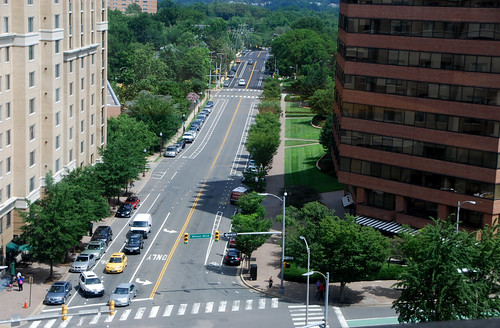
Veitch Street at Wilson Blvd, showing Veitch Street buffered bike lanes and Wilson Blvd green-painted bike lane.
Average Rating: 4.8 out of 5 based on 230 user reviews.
July 11th, 2013 | Permalink
Tags: bike, transportation

Back in 1926, a robust network of steamship routes ferried passengers up and down the Chesapeake Bay and Potomac River. This map shows how part of that network functioned.
The map only shows lines that served Baltimore, so it’s probably a safe bet that DC had more than just the one.
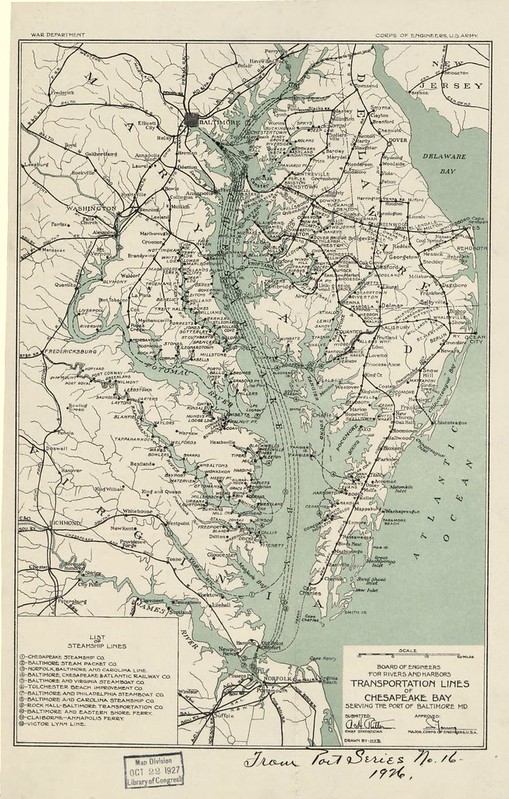
Public domain image from the US Library of Congress.
Originally produced by US Army.
Average Rating: 4.9 out of 5 based on 153 user reviews.
July 10th, 2013 | Permalink
Tags: history, transportation

Google Street View is an amazing tool, made even more amazing with its growing library of photography covering building interiors. Now you can use it to cyber-visit the observation deck at the world’s tallest skyscraper. Actually, you can see several floors in the burj, using the vertical slider on the left side navigation bar.
Still no Washington Monument, unfortch.
Someone should build a room with floor-to-ceiling screens, project Street View images onto each, and call it a holodeck.

Image from Google.
Average Rating: 4.5 out of 5 based on 210 user reviews.
July 9th, 2013 | Permalink
Tags: fun

|
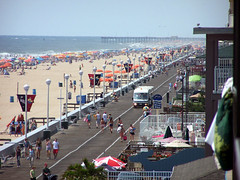
Ocean City’s boardwalk, with its tram. |
If you live in New York, Philadelphia, or Boston, you can hop onto a commuter rail train any summer weekend and travel to the beach. But not if you live in DC. Here we have no train, and the buses are impractical and expensive.
Let’s compare:
Boston’s Massachusetts Bay Transit Authority recently launched its Cape Flyer service, from Boston South Station to Cape Cod. A round trip ticket to Hyannis is $35.
New Jersey Transit runs trains from Philadelphia 30th Street Station to Atlantic City for $20 round trip, and from New York Penn Station to the Jersey Shore for $25 round trip. New Yorkers can also take Long Island Rail Road from Penn Station to Montauk for about $40 round trip.
For DC, there is no train, much less an affordable one. There are no tracks directly between DC and Maryland’s Eastern Shore. The only track connection is at the very top of Chesapeake Bay, near Wilmington, DE. Amtrak does offer service to Ocean City, but you have to connect to an Amtrak bus at BWI, and it’s $120 for a round trip.
Greyhound also runs buses from DC to Ocean City, but it’s $50-$100 per round trip, depending on how far in advance you buy tickets online.
Building a new rail bridge across Chesapeake Bay is probably not practical. Even if it were, that’s surely not the top priority for limited transit funding. But why not better bus service? Ocean City is a natural transit destination; it’s compact and urban, at least near the boardwalk.
As summer rolls by and Washingtonians head out for weekend jaunts to the beach, how many of us wish we didn’t have to rent a car to get there?
Average Rating: 4.9 out of 5 based on 244 user reviews.
July 8th, 2013 | Permalink
Tags: bus, commuterrail, intercity, proposal, question, transportation

Metro’s new 7000 series railcars are making progress at their factory in Japan. On Wednesday, WMATA posted this video of a new train moving under its own power.
7000 series cars will begin arriving in 2014.
 Cross-posted at Greater Greater Washington. Cross-posted at Greater Greater Washington.
Average Rating: 4.9 out of 5 based on 239 user reviews.
July 5th, 2013 | Permalink
Tags: metrorail, transportation

Developers floated a plan last month to drastically downscale the town center at Vienna MetroWest, but Lynda Smyth, the county supervisor for the area, said she never approved such a change, nor would the Board of Supervisors likely ever do so. Developers say they’re still committed to the full town center, but can’t do it right away.
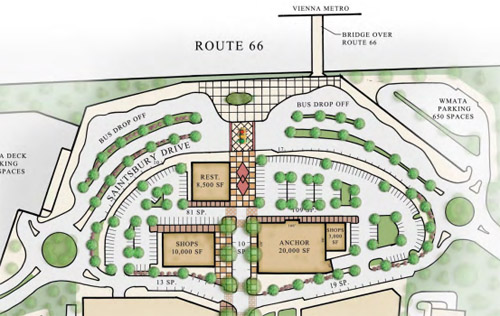
The downscaled proposal, with single-story buildings fronting onto parking lots. Image from Paraclete Realty.
Developers spoke with county supervisors and residents about the plans at a public meeting on June 18. According to resident Eric Bleeker, the room was packed, and many attendees came because they’d heard about the plan on Greater Greater Washington. Supervisor Smyth said she hadn’t seen the new proposal until it was posted to Greater Greater Washington, and would almost surely not approve it.
According to Tim Alexander of development firm Clark Realty, the downscaled proposal is supposed to be temporary. Clark still wants to build the full town center, but can’t find tenants for the originally proposed office buildings in the current economy. In the mean time, his company doesn’t want to leave that land empty for what could be years.
“The negativity to the plan was immense, ” said Bleeker, who lives at MetroWest. “After a good verbal lashing from Supervisor Smyth, the Clark representative spoke of wanting to work with the county on alternative ideas, and threw out pop-up retail.”
What now?
Unfortunately, Clark is between a rock and a hard place. Plan A, the full town center, is impossible in the short term due to the economy. Plan B, the downscaled version, is rightly unpopular. What could work for Plan C?
It would be short-sighted to simply build residential towers in the town center instead of offices. MetroWest would lose its planned mixed-use character. It would be harder to keep retail spaces full over the long term with neither daytime workers in walking distance nor a lot of car traffic passing by.
So temporary single-story buildings may be the only viable near-term option, even if “temporary” means years. But if that’s the case, Clark should strive to build a bona fide main street, rather than a couple of retail pad sites, with half of them fronting onto parking lots.
Even if parking lots are necessary, the main strip of activity should be the pedestrian-oriented walkway down the middle of the site, leading to the Metro station. All stores should front directly onto the main street, and there shouldn’t be any gaps in the street wall where a parking lot comes right up to the front.
If the full town center is years away then a temporary single-story retail town center may be an unfortunate reality, but even if so, Clark can do better.
 Cross-posted at Greater Greater Washington. Cross-posted at Greater Greater Washington.
Average Rating: 4.6 out of 5 based on 242 user reviews.
July 3rd, 2013 | Permalink
Tags: development, urbandesign

|
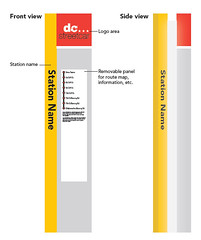
Streetcar station pylon sign. Image from DDOT. |
It’s going to be the summer of streetcar in DC, with increasingly rapid progress visible on H Street and at the vehicle testing site in Anacostia.
At last week’s streetcar community fair, DDOT representatives presented the timeline for vehicle testing, gave line-by-line construction and planning status updates, and showed images of streetcar station signs, power substations, the car barn, and more. The fair was one of the largest releases of new information in the program’s history.
Vehicle testing timeline
Workers at the streetcar testing and commissioning site on South Capitol Street have already started testing the mechanics and electronics of the 3 Czech-built streetcars currently in DC. They’ll begin dynamic testing around July 15, meaning that’s when streetcars will actually begin to move along track.
Around August, 1 the 3 streetcars will be turned over to DDOT’s operations and maintenance team for a month of crew training, before they’re moved to H Street for on-site testing around August 30 this autumn.
The first of the 3 new US-built United Streetcar vehicles is expected to arrive and begin testing in September.
Line by line updates on the 22-mile system
DC’s streetcar plans call for 37 miles of lines, but so far DDOT is only working on the first 22 miles.

The 22-mile system. Image from DDOT.
Work is progressing in 3 phases. Each line goes through alternatives planning, followed by environmental analysis, and then finally construction.
Right now, two segments are under construction, two are in the environmental stage, and 4 are in alternatives planning.
The H Street and Anacostia initial segment are under construction now, with H Street slated to open this year.
Planners expect environmental analysis to be finished this summer for the northern extension of the Anacostia line into central Anacostia, and for the eastern extension of the H Street line across the Anacostia River to Benning Metro.
Alternatives planning is complete for the M Street SE/SW line, and will soon be complete for the Union Station to Georgetown line. The north/south line will begin analysis this summer, with the Bolling Air Force Base extension of the Anacostia line following after that.
The car barn
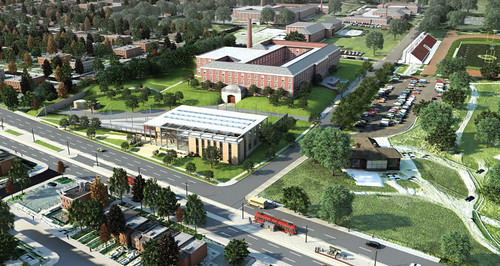
The car barn. Image from DDOT.
Streetcars will be stored and maintained over the long term in the car barn in front of Spingarn High School. The car barn design is still advancing through the Historic Preservation Review Board approval process, but is now making progress and is no longer facing delays.
Construction will begin this month on the tracks and non-building infrastructure at the car barn site, in anticipation of hosting streetcars later this year. The building itself should begin construction this fall, and open in summer 2014. DDOT can operate the streetcars with the tracks but not the building for a few months, so as long as the tracks at the car barn site are finished on time, the fact that the building will still be under construction this winter should not cause any delay.
Power substations
There will be 3 traction power substations along the H Street line, necessary to keep the streetcar’s overhead wires alive with electricity. The substations will be located at 2nd Street NE, 12th Street NE, and 25th Street NE.
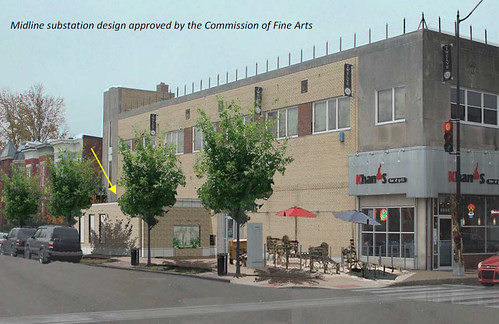
12th Street substation. Image from DDOT.
Approval was granted for the 12th Street substation in May, and construction is now imminent.
Keep up to date
It’s going to be a busy and exciting summer for streetcars in DC. To keep up with the latest, visit DCstreetcar.com
 Cross-posted at Greater Greater Washington. Cross-posted at Greater Greater Washington.
Correction: DDOT clarifies The 3 streetcars currently being tested at the commissioning site will be moved to H Street sometime this autumn, not at the end of August as originally reported.
Average Rating: 4.6 out of 5 based on 155 user reviews.
July 2nd, 2013 | Permalink
Tags: streetcar, transportation

|

Photo from Eric Allix Rogers on flickr. |
In the never ending debate about streetcars versus bus, rider comfort is a point of contention. Streetcar supporters say rail is smoother and more comfortable and therefore appeals to more people. Opponents say that’s overblown or doesn’t matter.
School buses prove it does matter.
The inside of school buses is much less comfortable than the inside of comparatively luxurious transit buses used for BRT. School buses have narrower aisles, and group benches instead of individual seats. They usually don’t have air conditioning. They’re high-floor, and ugly, and definitely uncool.
And although school buses are shorter than articulated buses, you could squeeze through the same capacity if you simply run more of them. That would be easy because school buses are way, way cheaper. A new school bus costs about $75, 000, versus maybe $700, 000 for an articulated transit bus.
Sound familiar?
So instead of attacking streetcars, why aren’t BRT proponents demanding school buses, and calling wasteful any proposal that uses unnecessarily expensive transit buses?
Because ride quality matters, and desirability matters, and because being cool matters if you hope to attract riders who can opt to drive whenever they want.
The arguments streetcar opponents use to denigrate the ride quality benefits of streetcars could be used with equal validity to denigrate BRT, in favor of school buses. But nobody makes that argument, because everyone knows it’s wrong.
If you want anybody other than captive minors to ride transit then you have to shell out for luxurious rider amenities.
Don’t be dogmatic, mind the details
Of course, none of this is a zero sum game. Sometimes school buses are the right solution, even though they stink compared to streetcars and transit buses. Likewise, sometimes BRT is the right solution, and sometimes it’s streetcar.
Even among the modes, it’s not zero sum. Just how much of a ride quality benefit rail provides can vary a lot depending on the specific vehicle and route.
Rail is typically smoother than bus for two reasons: The vehicle is heavier and therefore jostles around less, and gliding along a rail is inherently smoother than rumbling over asphalt. But individual results vary. The US-built Oregon Ironworks streetcar in Portland is reportedly pretty jerky. That’s due partly to a prototype propulsion system that isn’t quite right, but also partly to the fact that it’s one of the smallest and lightest modern streetcars on the market.
DC has 3 of those Oregon Ironworks streetcars on order right now. They’re supposedly improved over the prototype model, but if they aren’t as smooth as the 3 Czech-built streetcars currently being tested in Anacostia then DDOT may want to consider a different vendor for future purchases.
The trick, as with any decision, is to match the needs to the corridor.
For elementary school trips, the benefits of luxurious transit buses aren’t worth their added costs over school buses. For adult commuting trips that compete with cars, it’s worth it to pay more.
And although the benefits of rail aren’t worth the cost trade-offs for probably 90% of the bus routes in the region, there are a dozen or so high-profile corridors where it is worth the expense.
Average Rating: 4.7 out of 5 based on 194 user reviews.
July 1st, 2013 | Permalink
Tags: BRT, bus, streetcar, transportation

|
Media





Site
About BeyondDC
Archive 2003-06
Contact
Category Tags:
Partners
|
























